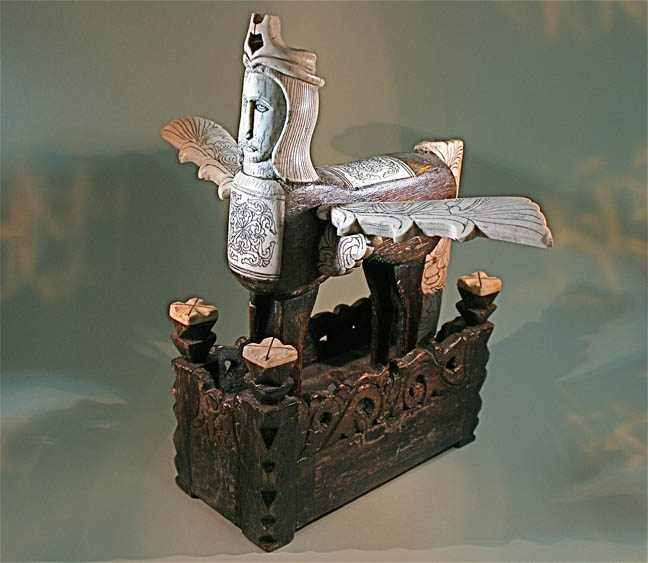

Title: Carved Wood and Bone Winged Horse from Assyria
Shipping: $29.00
Artist: N/A
Period: Unassigned
History: N/A
Origin: N/A
Condition: Museum Quality
Item Date: 1300 to 1800
Item ID: 1636
Assyrian, or Babylonian, or Hittite "winged horse." This is a "modern" impression (1300 to 1800) of an ancient wooden horse inlayed with bone, after the original 13th to 17th century B.C. work. Middle Assyrian style. We think it can be dated on stylistic grounds to the late 14th to 13th century B.C., a period of intense interaction between the eastern Mediterranean world and the Near East: the geographical range extends from Anatolia to Mesopotamia and Iran, with rich material from Syria and Cyprus. Large monumental sculpture, often with wings and always with human heads, were placed as gateway guardians at the entrances of royal palaces like Khorsabad and Nineveh. The general idea behind them was that they warded off evil. (In jargon: they were apotropaic figures.) These monumental statues were called aladlammû ("protective spirit") or lamassu, which means that the original female word was now applied for a rather macho demon. In one modern interpretation, they combine strength, freedom, and intelligence.
Link: http://en.wikipedia.org/wiki/Assyria
assyria OR babylon OR hittite "winged horse"
The overspreading of the land by his "mighty ones," or hosts of armed men, that the king of Babylon was to bring with him in his overflowing invasion! The knowledge of the way in which the Assyrian monarchs were represented, and of the meaning of that representation, gives additional force to the story of the dream of Cyrus the Great, as told by Herodotus. Cyrus, says the historian, dreamt that he saw the son of one of his princes, who was at the time in a distant province, with two great "wings on his shoulders, the one of which overshadowed Asia, and the other Europe," from which he immediately concluded that he was organising rebellion against him. The symbols of the Babylonians, whose capital Cyrus had taken, and to whose power he had succeeded, were entirely familiar to him; and if the "wings" were the symbols of sovereign power, and the possession of them implied the lordship over the might, or the armies of the empire, it is easy to see how very naturally any suspicions of disloyalty affecting the individual in question might take shape in the manner related, in the dreams of him who might harbour these suspicions. After one victory at Agbatana in Syria, Cyrus was told how to subdue the enemy captives: Grant, then, forgiveness to the Lydians, and to make sure of their never rebelling against thee, or alarming thee more, send and forbid them to keep any weapons of war, command them to wear tunics under their cloaks, and to put buskins upon their legs, and make them bring up their sons to cithern-playing (Kitharizein), singing (psallein), and shop-keeping (Hucksterism). (Or translated lyre playing and harping which is redundant) So wilt thou soon see them become women instead of men,
and there will be no more fear of their revolting from thee." Now, the understanding of this equivocal sense of "Baal-aberin" can alone explain the remarkable statement of Aristophanes, that at the beginning of the world "the birds" were first created, and then after their creation, came the "race of the blessed immortal gods." This has been regarded as either an atheistical or nonsensical utterance on the part of the poet, but, with the true key applied to the language, it is found to contain an important historical fact. Let it only be borne in mind that "the birds"--that is, the "winged ones"--symbolised "the Lords of the mighty ones," and then the meaning is clear, viz., that men first "began to be mighty on the earth"; and then, that the "Lords" or Leaders of "these mighty ones" were deified. The knowledge of the mystic sense of this symbol accounts also for the origin of the story of Perseus, the son of Jupiter, miraculously born of Danae, who did such wondrous things, and who passed from country to country on wings divinely bestowed on him. This equally casts light on the symbolic myths in regard to Bellerophon, and the feats which he performed on his winged horse, and their ultimate disastrous issue; how high he mounted in the air, and how terrible was his fall; and of Icarus, the son of Daedalus, who, flying on wax-cemented wings over the Icarian Sea, had his wings melted off through his too near approach to the sun, and so gave his name to the sea where he was supposed to have fallen. The fables all referred to those who trode, or were supposed to have trodden, in the steps of Nimrod, the first "Lord of the mighty ones," and who in that character was symbolised as equipped with wings. Now, it is remarkable that, in the passage of Aristophanes already referred to, that speaks of the birds, or "the winged ones," being produced before the gods, we are informed that he from whom both "mighty ones" and gods derived their origin, was none other than the winged boy Cupid. * Aristophanes says that Eros or Cupid produced the "birds" and "gods" by "mingling all things." This evidently points to the meaning of the name Bel, which signifies at once "the mingler" and "the confounder." This name properly belonged to the father of Nimrod, but, as the son was represented as identified with the father, we have evidence that the name descended to the son and others by inheritance.